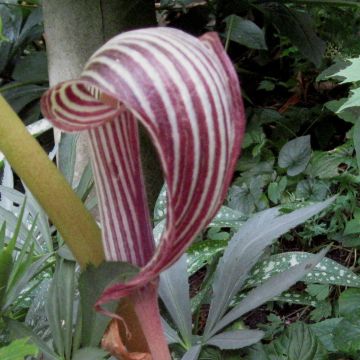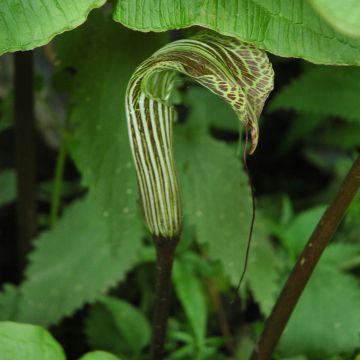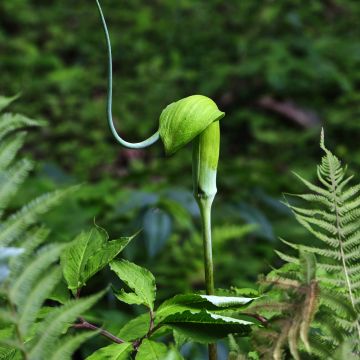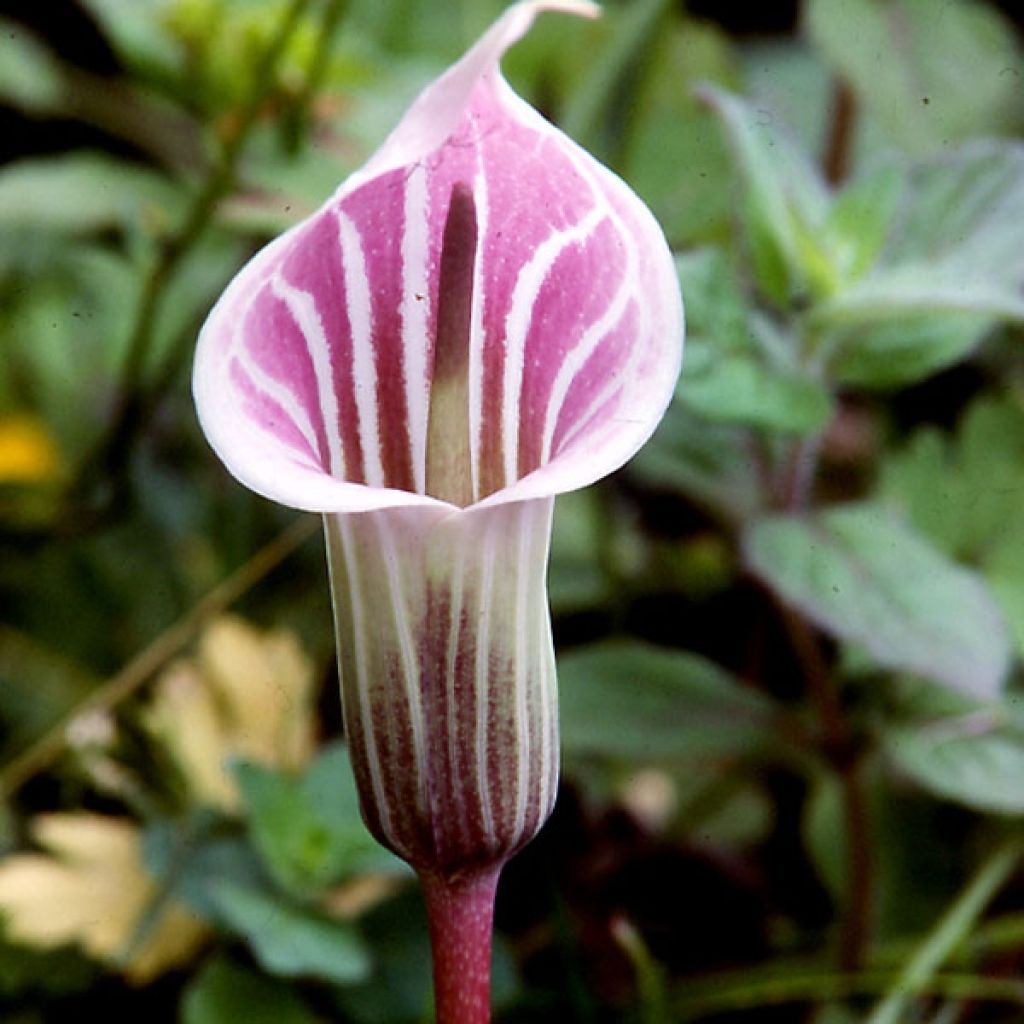

Arisaema candidissimum
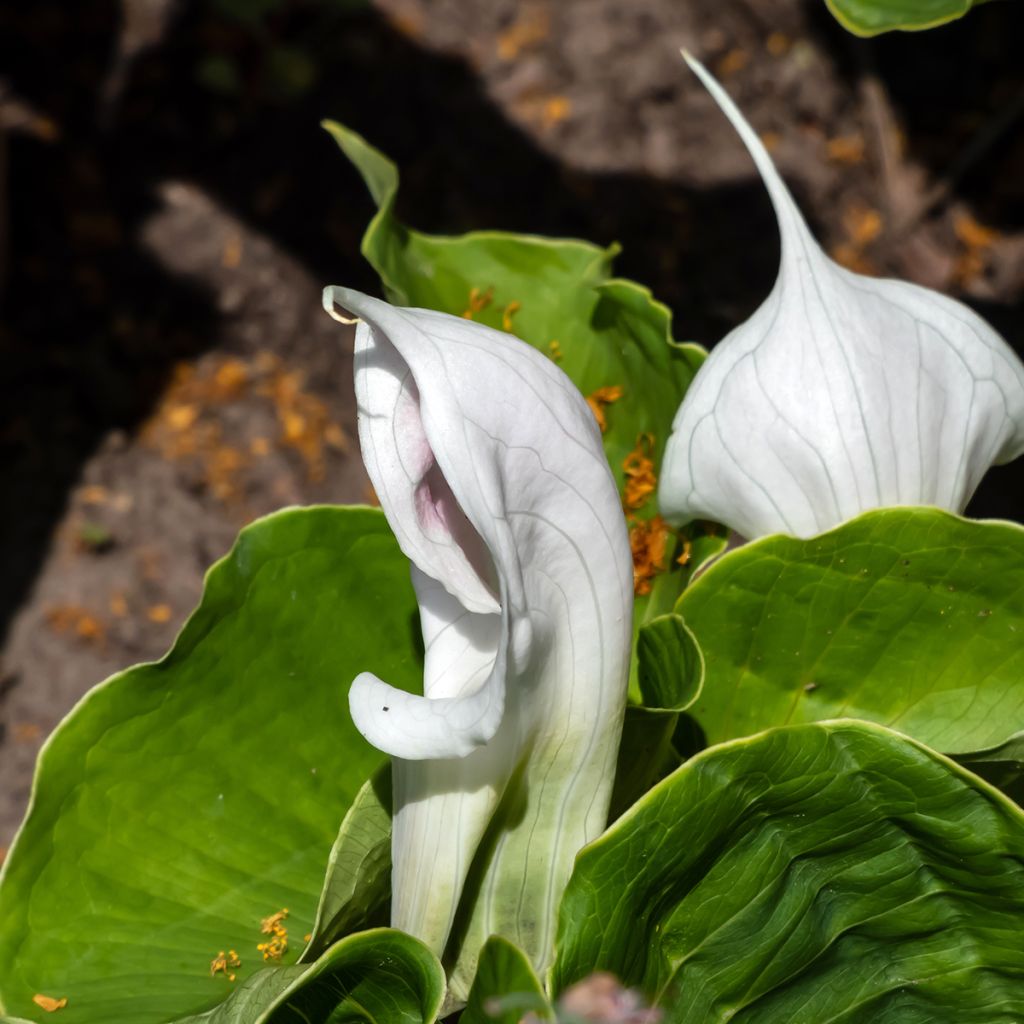

Arisaema candidissimum
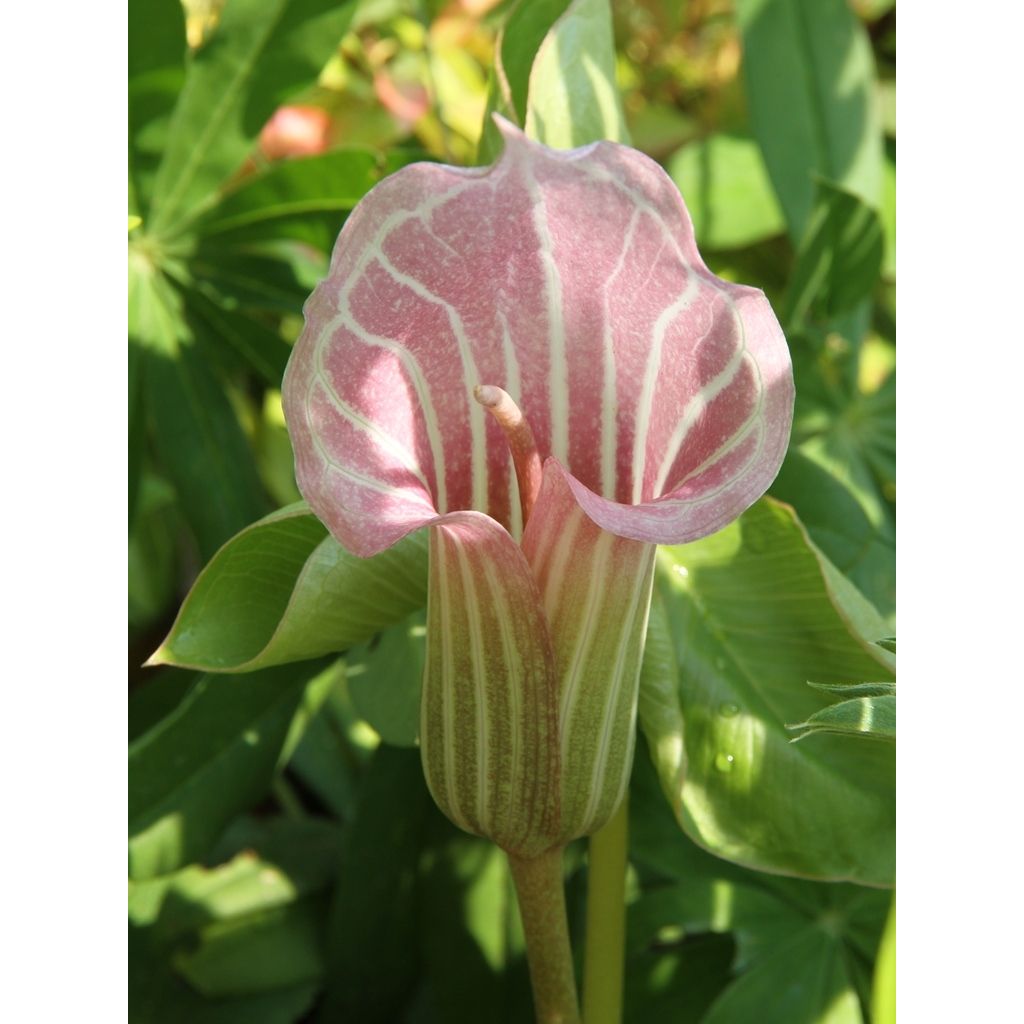

Arisaema candidissimum
Arisaema candidissimum
Arisaema candidissimum
White-Spathed Jack in the Pulpit, Cobra Lily
I have received 3 healthy and promising bulbs, we must wait for the flowers.
Béatrice , 21/02/2023
This plant carries a 12 months recovery warranty
More information
We guarantee the quality of our plants for a full growing cycle, and will replace at our expense any plant that fails to recover under normal climatic and planting conditions.
From €5.90 for pickup delivery and €6.90 for home delivery
Express home delivery from €8.90.


Does this plant fit my garden?
Set up your Plantfit profile →
Description
The Arisaema candidissimum forms sublime upright flowers, white, streaked with green and soft pink.
In bloom in early summer, the Arisaema candidissimum reaches 30 to 40cm (12 to 16in) in height, its spathe (the name given to the flowers of this family) subtly fragrant, is white streaked with green and soft pink. Decorative, its leaves are composed of 3 large leaflets, rounded and light green in colour. Its corms (bulbs) are pink-red and perfectly round, they produce small bulblets and slowly spread in the soil. Allow 3 years to obtain a beautiful clump of 5-7 flowers.
From the same family as Arums, this Asian cousin, nicknamed "Cobra lily" by the English due to its upright spathe evoking a strong mimicry with this reptile, is still under used in gardens. Originating mainly from Asia, there are currently more than 150 species. Over half of these species live in temperate zones and are therefore easily cultivable in our climates. They like wooded environments, humus-bearing and cool soils, but never waterlogged.
Plant Arisaema candidissimum in a cool environment in the company of bamboos (Fargesia), hostas, and ferns.
Report an error about the product description
Flowering
Foliage
Plant habit
Botanical data
Arisaema
candidissimum
Araceae
White-Spathed Jack in the Pulpit, Cobra Lily
China
Other Arisaemas
Planting and care
Arisaemas are generally sturdy plants as long as their needs are met. They prefer soil that is rich in humus, light and well-draining. During summer, make sure that the soil doesn't dry out, but during winter, it shouldn't be saturated with water either as the bulb will rot in case of high winter humidity. For planting, partial shade is recommended at the edge of large trees, with westward exposure being ideal. If the soil is heavy, mix 1/3 leaf compost and 1/3 non-chalky sand with your topsoil to a depth and width of 20-25cm (8-10in). When planting the bulb, place it on a small bed of perlite and cover it with your substrate at a depth of 6-8cm (2-3in) to prevent rotting in winter. For potted plants, use a wide terracotta pot that is preferably short, filled with a substrate made of half perlite or vermiculite and leaf compost. Bury the bulbs 6-8cm (2-3in) underground and keep the soil moist but not waterlogged. During winter, store your pot in a frost-free area and maintain a slight coolness. A few drops of water every 15 days will suffice. Resume watering only in early spring, around April, as soon as the bulbs start to emerge.
Planting period
Intended location
Care
-
, onOrder confirmed
Reply from on Promesse de fleurs
Haven't found what you were looking for?
Hardiness is the lowest winter temperature a plant can endure without suffering serious damage or even dying. However, hardiness is affected by location (a sheltered area, such as a patio), protection (winter cover) and soil type (hardiness is improved by well-drained soil).

Photo Sharing Terms & Conditions
In order to encourage gardeners to interact and share their experiences, Promesse de fleurs offers various media enabling content to be uploaded onto its Site - in particular via the ‘Photo sharing’ module.
The User agrees to refrain from:
- Posting any content that is illegal, prejudicial, insulting, racist, inciteful to hatred, revisionist, contrary to public decency, that infringes on privacy or on the privacy rights of third parties, in particular the publicity rights of persons and goods, intellectual property rights, or the right to privacy.
- Submitting content on behalf of a third party;
- Impersonate the identity of a third party and/or publish any personal information about a third party;
In general, the User undertakes to refrain from any unethical behaviour.
All Content (in particular text, comments, files, images, photos, videos, creative works, etc.), which may be subject to property or intellectual property rights, image or other private rights, shall remain the property of the User, subject to the limited rights granted by the terms of the licence granted by Promesse de fleurs as stated below. Users are at liberty to publish or not to publish such Content on the Site, notably via the ‘Photo Sharing’ facility, and accept that this Content shall be made public and freely accessible, notably on the Internet.
Users further acknowledge, undertake to have ,and guarantee that they hold all necessary rights and permissions to publish such material on the Site, in particular with regard to the legislation in force pertaining to any privacy, property, intellectual property, image, or contractual rights, or rights of any other nature. By publishing such Content on the Site, Users acknowledge accepting full liability as publishers of the Content within the meaning of the law, and grant Promesse de fleurs, free of charge, an inclusive, worldwide licence for the said Content for the entire duration of its publication, including all reproduction, representation, up/downloading, displaying, performing, transmission, and storage rights.
Users also grant permission for their name to be linked to the Content and accept that this link may not always be made available.
By engaging in posting material, Users consent to their Content becoming automatically accessible on the Internet, in particular on other sites and/or blogs and/or web pages of the Promesse de fleurs site, including in particular social pages and the Promesse de fleurs catalogue.
Users may secure the removal of entrusted content free of charge by issuing a simple request via our contact form.
The flowering period indicated on our website applies to countries and regions located in USDA zone 8 (France, the United Kingdom, Ireland, the Netherlands, etc.)
It will vary according to where you live:
- In zones 9 to 10 (Italy, Spain, Greece, etc.), flowering will occur about 2 to 4 weeks earlier.
- In zones 6 to 7 (Germany, Poland, Slovenia, and lower mountainous regions), flowering will be delayed by 2 to 3 weeks.
- In zone 5 (Central Europe, Scandinavia), blooming will be delayed by 3 to 5 weeks.
In temperate climates, pruning of spring-flowering shrubs (forsythia, spireas, etc.) should be done just after flowering.
Pruning of summer-flowering shrubs (Indian Lilac, Perovskia, etc.) can be done in winter or spring.
In cold regions as well as with frost-sensitive plants, avoid pruning too early when severe frosts may still occur.
The planting period indicated on our website applies to countries and regions located in USDA zone 8 (France, United Kingdom, Ireland, Netherlands).
It will vary according to where you live:
- In Mediterranean zones (Marseille, Madrid, Milan, etc.), autumn and winter are the best planting periods.
- In continental zones (Strasbourg, Munich, Vienna, etc.), delay planting by 2 to 3 weeks in spring and bring it forward by 2 to 4 weeks in autumn.
- In mountainous regions (the Alps, Pyrenees, Carpathians, etc.), it is best to plant in late spring (May-June) or late summer (August-September).
The harvesting period indicated on our website applies to countries and regions in USDA zone 8 (France, England, Ireland, the Netherlands).
In colder areas (Scandinavia, Poland, Austria...) fruit and vegetable harvests are likely to be delayed by 3-4 weeks.
In warmer areas (Italy, Spain, Greece, etc.), harvesting will probably take place earlier, depending on weather conditions.
The sowing periods indicated on our website apply to countries and regions within USDA Zone 8 (France, UK, Ireland, Netherlands).
In colder areas (Scandinavia, Poland, Austria...), delay any outdoor sowing by 3-4 weeks, or sow under glass.
In warmer climes (Italy, Spain, Greece, etc.), bring outdoor sowing forward by a few weeks.

































